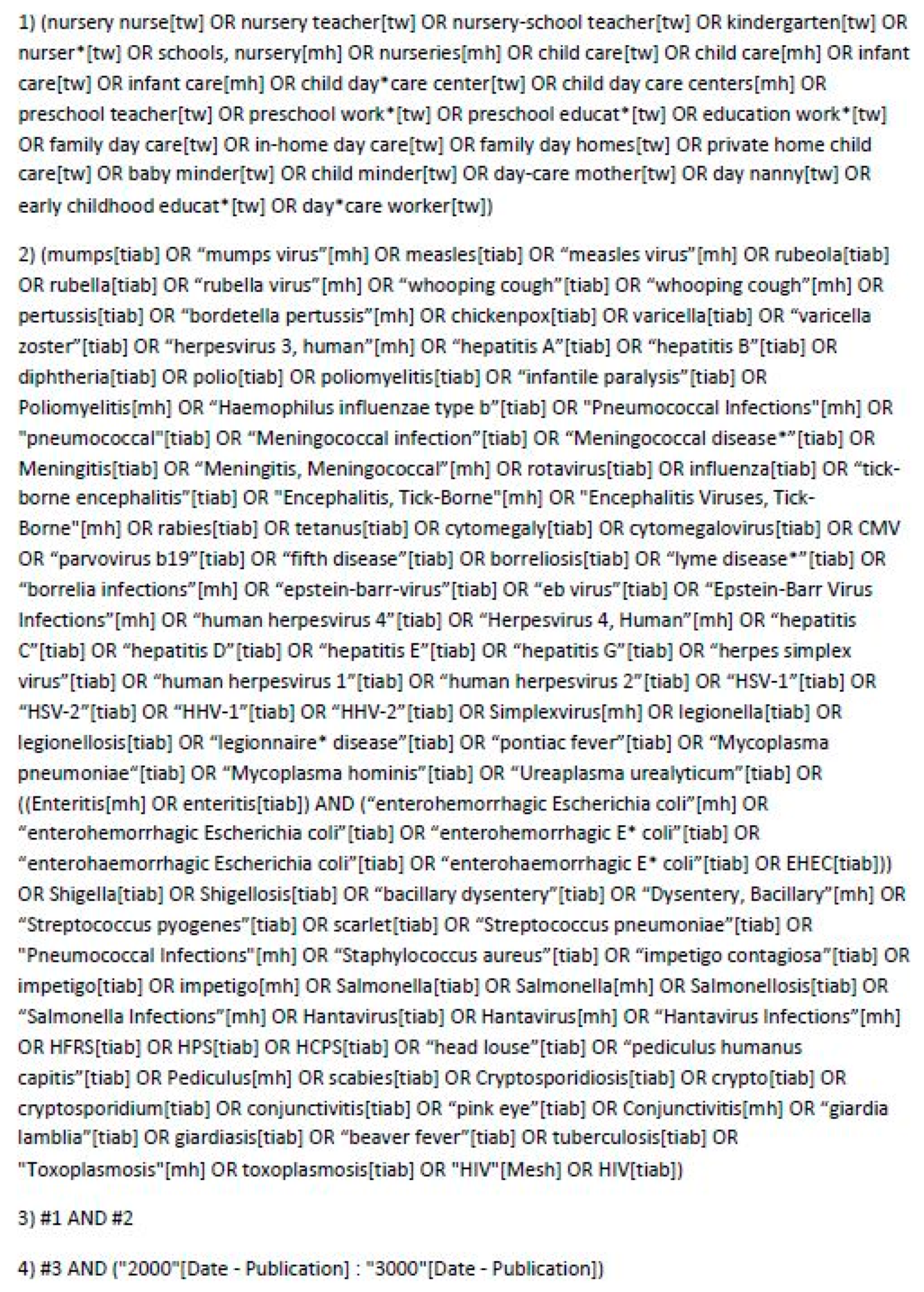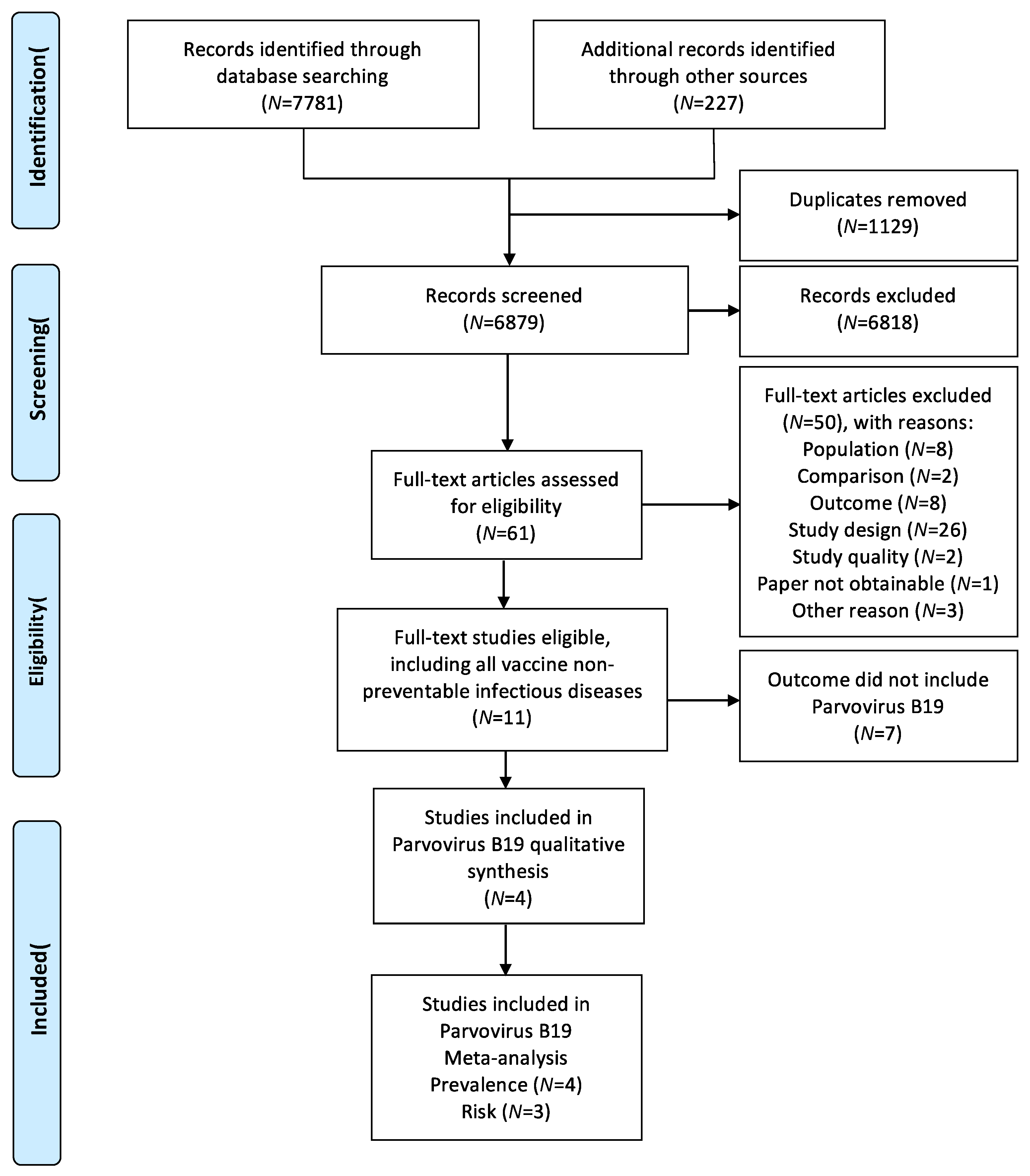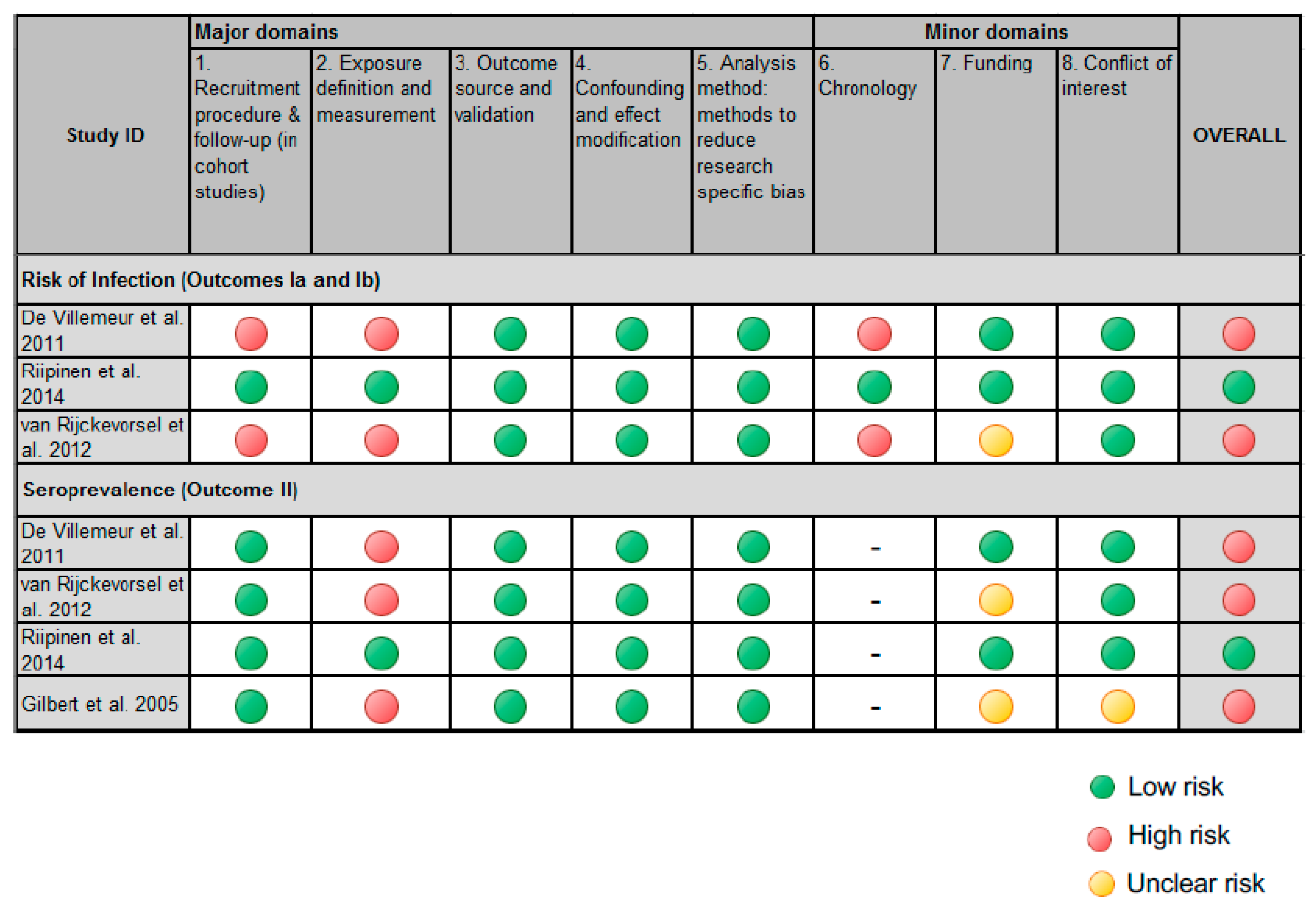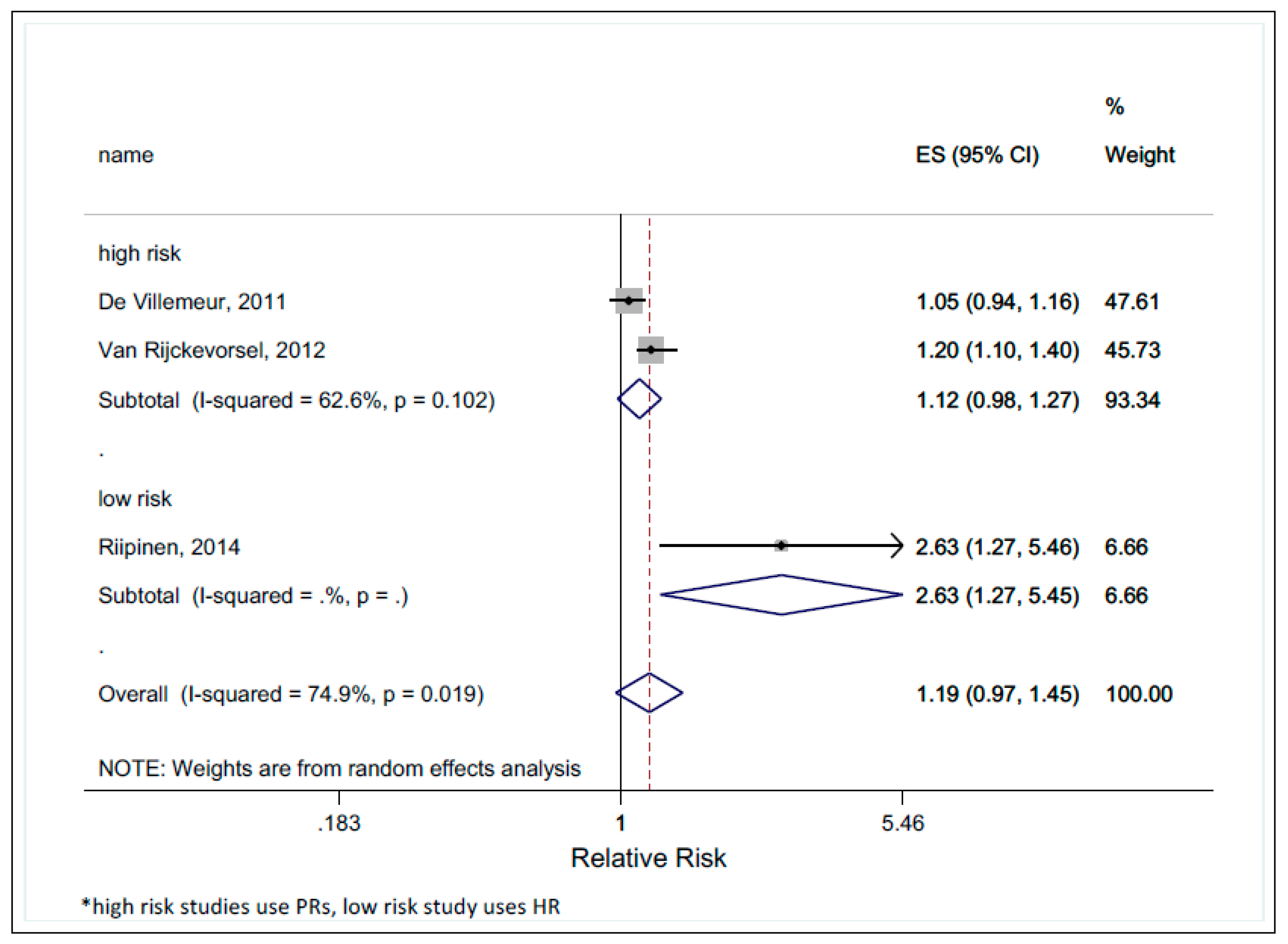Are Daycare Workers at a Higher Risk of Parvovirus B19 Infection? A Systematic Review and Meta-Analysis
Abstract
1. Introduction
2. Methods
2.1. Protocol and Registration
2.2. Search, Selection, and Data Extraction
2.3. Risk of Bias Assessment
2.4. Overall Assessment of Risk of Bias
2.5. Statistical Analysis
2.6. GRADE: Quality of Evidence Assessment
3. Results
3.1. Search Results
3.2. Risk of Infection (Outcomes Ia and Ib)
3.3. Parvovirus B19 Seroprevalence (Outcome II)
4. Discussion
4.1. Agreement with Other Studies and Reviews
4.2. Strengths and Limitations
4.3. The Methodological Quality of Included Studies
4.4. Implications for Practice and Research
5. Conclusions
Supplementary Materials
Author Contributions
Funding
Conflicts of Interest
References
- Young, N.S.; Brown, K.E. Parvovirus B19. N. Engl. J. Med. 2004, 350, 586–597. [Google Scholar] [CrossRef] [PubMed]
- Crane, J. Society of Obstetricians and Gynaecologists of Canada. Parvovirus B19 infection in pregnancy. J. Obstet. Gynaecol. Can. 2002, 24, 727–743. [Google Scholar] [PubMed]
- Koch, W.C.; Harger, J.H.; Barnstein, B.; Adler, S.P. Serologic and virologic evidence for frequent intrauterine transmission of human parvovirus B19 with a primary maternal infection during pregnancy. Pediatr. Infect. Dis. J. 1998, 17, 489–494. [Google Scholar] [CrossRef] [PubMed]
- Koch-Institut, R. Parvovirus B19. Bundesgesundheitsblatt 2010, 53, 944–956. [Google Scholar]
- Giorgio, E.; De Oronzo, M.A.; Iozza, I.; Di Natale, A.; Cianci, S.; Garofalo, G.; Giacobbe, A.M.; Politi, S. Parvovirus B19 during pregnancy: A review. J. Prenat. Med. 2010, 4, 63–66. [Google Scholar] [PubMed]
- Handbuch, D. 111 parvovirus-B19-infektionen. In DGPI Handbuch, 7th ed.; Berner, R., Bialek, R., Forster, J., Härtel, C., Heininger, U., Huppertz, H.-I., Liese, J.G., Nadal, D., Simon, A., Eds.; Georg Thieme Verlag: Stuttgart, Germany, 2018. [Google Scholar]
- Mossong, J.; Hens, N.; Friederichs, V.; Davidkin, I.; Broman, M.; Litwinska, B.; Siennicka, J.; Trzcinska, A.; Van Damme, P.; Beutels, P.; et al. Parvovirus B19 infection in five European countries: Seroepidemiology, force of infection and maternal risk of infection. Epidemiol. Infect. 2008, 136, 1059–1068. [Google Scholar] [CrossRef]
- Enders, M.; Weidner, A.; Enders, G. Current epidemiological aspects of human parvovirus B19 infection during pregnancy and childhood in the western part of Germany. Epidemiol. Infect. 2007, 135, 563–569. [Google Scholar] [CrossRef]
- Valeur-Jensen, A.; Pedersen, C.B.; Westergaard, T.; Jensen, I.P.; Lebech, M.; Andersen, P.K.; Aaby, P.; Pedersen, B.N.; Melbye, M. Risk factors for parvovirus B19 infection in pregnancy. JAMA 1999, 281, 1099–1105. [Google Scholar] [CrossRef] [PubMed]
- Gilbert, G. Parvovirus B19 infection and its significance in pregnancy. Commun. Dis. Intell. 2000, 24, 69–71. [Google Scholar] [PubMed]
- Elsner, G.; Petereit-Haack, G.; Nienhaus, A. Berufsbedingte infektionen bei erzieherinnen und erziehern in kindergärten. Zentralbl. Arbeitsmed. Arbeitsschutz Ergonomie 2009, 59, 39–42. [Google Scholar]
- Stroup, D.F.; Berlin, J.A.; Morton, S.C.; Olkin, I.; Williamson, G.D.; Rennie, D.; Moher, D.; Becker, B.J.; Sipe, T.A.; Thacker, S.B.; et al. Meta-analysis of observational studies in epidemiology: A proposal for reporting. JAMA 2000, 283, 2008–2012. [Google Scholar] [CrossRef] [PubMed]
- Moher, D.; Liberati, A.; Tetzlaff, J.; Altman, D.G.; The PRISMA Group. Preferred reporting items for systematic reviews and meta-analyses: The prisma statement. PLoS Med. 2009, 6, 264–269. [Google Scholar] [CrossRef]
- Higgins, J.; Green, S. Cochrane Handbook for Systematic Reviews of Interventions; The Cochrane Collaboration: London, UK, 2011. [Google Scholar]
- Bakkalbasi, N.; Bauer, K.; Glover, J.; Wang, L. Three options for citation tracking: Google scholar, Scopus and Web of Science. Biomed. Digit. Libr. 2006, 3, 7. [Google Scholar] [CrossRef] [PubMed]
- Giles, J. Science in the web age: Start your engines. Nature 2005, 438, 554. [Google Scholar] [CrossRef]
- Ijaz, S.; Verbeek, J.; Seidler, A.; Lindbohm, M.-L.; Ojajärvi, A.; Orsini, N.; Costa, G.; Neuvonen, K. Night-shift work and breast cancer—A systematic review and meta-analysis. Scand. J. Work Environ. Health 2013, 39, 431–447. [Google Scholar] [CrossRef] [PubMed]
- Shamliyan, T.A.; Kane, R.L.; Ansari, M.T.; Raman, G.; Berkman, N.D.; Grant, M.; Janes, G.; Maglione, M.; Moher, D.; Nasser, M.; et al. Development quality criteria to evaluate nontherapeutic studies of incidence, prevalence, or risk factors of chronic diseases: Pilot study of new checklists. J. Clin. Epidemiol. 2011, 64, 637–657. [Google Scholar] [CrossRef] [PubMed]
- Scottish Intercollegiate Guidelines Network. Available online: https://www.sign.ac.uk/checklists-and-notes.html (accessed on 27 March 2019).
- Critical Appraisal Skills Programme. Available online: https://casp-uk.net/casp-tools-checklists/ (accessed on 27 March 2019).
- Guyatt, G.; Oxman, A.D.; Akl, E.A.; Kunz, R.; Vist, G.; Brozek, J.; Norris, S.; Falck-Ytter, Y.; Glasziou, P.; Jaeschke, R. Grade guidelines: 1. Introduction—Grade evidence profiles and summary of findings tables. J. Clin. Epidemiol. 2011, 64, 383–394. [Google Scholar] [CrossRef] [PubMed]
- Kuijer, P.P.F.M.; Verbeek, J.H.; Seidler, A.; Ellegast, R.; Hulshof, C.T.J.; Frings-Dresen, M.H.W.; van der Molen, H.F. Work-relatedness of lumbosacral radiculopathy syndrome: Review and dose-response meta-analysis. Neurology 2018, 91, 558–564. [Google Scholar] [CrossRef] [PubMed]
- De Villemeur, A.B.; Gratacap-Cavallier, B.; Casey, R.; Baccard-Longere, M.; Goirand, L.; Seigneurin, J.M.; Morand, P. Occupational risk for cytomegalovirus, but not for parvovirus B19 in child-care personnel in France. J. Infect. 2011, 63, 457–467. [Google Scholar] [CrossRef] [PubMed]
- Riipinen, A.; Sallmen, M.; Hedman, L.; Ojajarvi, A.; Lindbohm, M.L.; Meriluoto, M.; Surcel, H.M.; Taskinen, H.; Nuutila, M.; Karikoski, R.; et al. Increased risk of human parvovirus B19 infection in day-care employees: A cohort study among pregnant workers during an epidemic in Finland. Occup. Environ. Med. 2014, 71, 836–841. [Google Scholar] [CrossRef] [PubMed]
- Van Rijckevorsel, G.G.; Bovee, L.P.; Damen, M.; Sonder, G.J.; van der Loeff, M.F.S.; van den Hoek, A. Increased seroprevalence of IgG-class antibodies against cytomegalovirus, parvovirus B19, and varicella-zoster virus in women working in child daycare. BMC Public Health 2012, 12, 475. [Google Scholar] [CrossRef]
- Gilbert, N.L.; Gyorkos, T.W.; Beliveau, C.; Rahme, E.; Muecke, C.; Soto, J.C. Seroprevalence of parvovirus B19 infection in daycare educators. Epidemiol. Infect. 2005, 133, 299–304. [Google Scholar] [CrossRef] [PubMed][Green Version]
- Fassaert, T.; De Wit, M.A.; Verhoeff, A.P.; Tuinebreijer, W.C.; Gorissen, W.H.; Beekman, A.T.; Dekker, J. Uptake of health services for common mental disorders by first-generation Turkish and Moroccan migrants in The Netherlands. BMC Public Health 2009, 9, 307. [Google Scholar] [CrossRef] [PubMed]
- De Wit, M.A.S.; Tuinebreijer, W.C.; Dekker, J.; Beekman, A.-J.T.F.; Gorissen, W.H.M.; Schrier, A.C.; Penninx, B.W.J.H.; Komproe, I.H.; Verhoeff, A.P. Depressive and anxiety disorders in different ethnic groups. Soc. Psychiatry Psychiatr. Epidemiol. 2008, 43, 905–912. [Google Scholar] [CrossRef] [PubMed]
- Röhrer, C.; Gärtner, B.; Sauerbrei, A.; Böhm, S.; Hottenträger, B.; Raab, U.; Thierfelder, W.; Wutzler, P.; Modrow, S. Seroprevalence of parvovirus B19 in the German population. Epidemiol. Infect. 2008, 136, 1564–1575. [Google Scholar] [CrossRef] [PubMed]
- Gärtner, B.; Enders, M.; Luft-Duchow, C.; Bocharov, G.; Modorow, S. Parvovirus-B19-infektionen bei schwangeren in der kinderbetreuung. Bundesgesundheitsblatt-Gesundheitsforschung-Gesundheitsschutz 2007, 50, 1369. [Google Scholar] [CrossRef] [PubMed]




| First Author, Publication Year | Study Region | Study Design | Population | Exposure, Duration of Employment, Job Duties | Outcome Measurement | ||
|---|---|---|---|---|---|---|---|
| Sample Population | No. of Exposed/ No. of Unexposed (Response, Age) Follow-up (%) | Time of Recruitment | |||||
| De Villemeur et al. 2011 | France | Cross-sectional study | Women 20–50 yr, not pregnant, employed in either 1 of 83 child daycare centers (exposed) or in 1 of 2 business organizations (unexposed) | Exposed N = 395 (all women) Age characteristics: Mean: 39.0 yr Range: 38.3–39.7 yr Response: 63.3% Not exposed N = 382 (all women) Age characteristics: Mean: 39.3 yr Range: 33.1–34.8 yr Response: N.A. † | 2005–2007 | Self-administered questionnaires Duration of employment: N.A. Job duties: N.A. | Blood samples EIA® anti-B19 IgG (Biotrin) |
| Riipinen et al. 2014 | Finland | Retrospective cohort study | Pregnant women from the Finnish Maternity Cohort, who were pregnant during September 1992–August 1993 | Serological analysis (baseline) Exposed N = 1162 (all women) Age characteristics: Distribution: 19–24 yr: 212 (10.8%) 25–29 yr: 935 (47.6%) 30–34 yr: 638 (32.5%) 35–48 yr: 181 (9.2%) Not exposed N = 60 (all women) Age characteristics: not specified, but in reproductive age Response: 96.9% (all groups) Cord blood samples (follow-up) Exposed N = 331 Not exposed N = 60 (other occupation) N = 326 (healthcare workers) Follow-up: 56.6% (all exposure groups) | September 1992–August 1993 | Nursery school teachers identified from files of Trade Union of Education (95% unionization rate for teachers) and the Union of Professional Social Workers. Other occupations identified from the register of National Supervisory Authority for Welfare and Health To define employment-verified occupation, the registers of the Finnish Center for Pensions were used. | B19V IgG by an indirect enzyme immunoassay using streptavidin-bound biotinylated virus-like particles of virus protein 2 as an antigen. |
| Van Rijckevorsel et al. 2012 | The Netherlands | Cross-sectional study | Childcare personnel working in 38 daycare centers on the Amsterdam municipal register (exposed), compared to women not working in daycare from Amsterdam Health Monitor (AMH) survey (unexposed) | Exposed N = 242 (all women) Age characteristics: Mean: 29.0 yr Inter-quartile range (IQR): 24–35 yr Response: “nearly all agreed to participate” (~100%) Not exposed N = 298 (all women) Age characteristics: Mean: 35 yr IQR: 28–40 yr Response = 43.8% | Daycare center employees: 2007 Unexposed group: 2004 | Face interviews and through a cross-sectional survey in 2007 by the Public Health Service of Amsterdam Duration of employment: N.A. Job duties: N.A. | Blood samples NovaLisa Parvovirus B19 recombinant IgG ELISA ‡ |
| Gilbert et al. 2005 | Canada | Cross-sectional study | Educators working in daycare centers which were in current operation, enrolled children under 36 months and employed at least six educators. Educators had to be employed for at least 15 h/week and cared for children <60 months of age. | Exposed N = 477 (all women) Age characteristics:Mean: 34 years Range: 17–70 years <50 yr (91%) Response at daycare level: 53.3% Individual response: 44.3% | October–December 2001 | Questionnaires sent to directors and educators Duration of employment <5 yr: n = 162 (34.0%) 5–9 yr: n = 132 (27.7%) 10–14 yr: n = 106 (22.3%) ≥15 yr: n = 76 (16.0%) | ELISA parvovirus B19 IgG Biotrin International Ltd., Dublin, Ireland |
| † N.A. = not available ‡ ELISA = enzyme-linked immunosorbent assay | |||||||
| Risk Estimates (Outcomes Ia and Ib) | Seroprevalence Estimates (Outcome II) | ||||||
|---|---|---|---|---|---|---|---|
| Study ID | Effect Estimate | Effect Value | Adjusted for | Further Analysis | Age Category | Seroprevalence, % in Daycare Workers | Other Analysis |
| De Villemeur et al. 2011 | PR † (Outcome Ib) | 1.05 (0.94–1.16) | Age, occupational group, number of own children, attendance/duration of in-home childcare and/or informal child-care and/or child-care facility, and residence in a country of low/medium economic development | - | all | 79.4 (75.1–83.3) | - |
| ≤37 years | 67.7 (59.0–75.5) | ||||||
| >37 years | 85.4 (80.6–89.5) | ||||||
| Riipinenet al. 2014 | HR ‡ (Outcome Ia) | Daycare worker HR = 2.63 (1.27–5.46) Other occupation HR = 0.85 (0.18–4.09) Reference: health care workers | Age, employment, number of children, high infection risk period, capital region | Nulliparous women only: HR = 5.59 (1.40–22.4) | all | 59.1 (56.9–61.3) | - |
| 19–34 years | 58.9 (56.6–61.2) | ||||||
| 35–48 years | 61.3 (53.8–68.5) | ||||||
| Van Rijckevorsel et al. 2012 | PR † (Outcome Ib) | 1.2 (1.1–1.4) | Age, country of birth, having children | - | all | 72.2 (66.7–78.2) | - |
| Gilbert et al. 2005 | - | - | - | - | all | 69.8 (65.5–73.9) | Seroprevalence by experience in daycare: <5 yr: 61.1% (95% CI 53.1–68.7) 5–9 yr: 71.2% (95% CI 62.7–78.8) 10–14 yr: 75.5% (95% CI 66.2–83.3) ≥15 yr: 77.6% (95% CI 66.6–86.4) |
| ≤34 years | 64.6 (58.2–70.6) | ||||||
| >34 years | 75.5 (69.5–81.0) | ||||||
| † Prevalence Ratio ‡ Hazard Ratio | |||||||
© 2019 by the authors. Licensee MDPI, Basel, Switzerland. This article is an open access article distributed under the terms and conditions of the Creative Commons Attribution (CC BY) license (http://creativecommons.org/licenses/by/4.0/).
Share and Cite
Romero Starke, K.; Kofahl, M.; Freiberg, A.; Schubert, M.; Groß, M.L.; Schmauder, S.; Hegewald, J.; Kämpf, D.; Stranzinger, J.; Nienhaus, A.; et al. Are Daycare Workers at a Higher Risk of Parvovirus B19 Infection? A Systematic Review and Meta-Analysis. Int. J. Environ. Res. Public Health 2019, 16, 1392. https://doi.org/10.3390/ijerph16081392
Romero Starke K, Kofahl M, Freiberg A, Schubert M, Groß ML, Schmauder S, Hegewald J, Kämpf D, Stranzinger J, Nienhaus A, et al. Are Daycare Workers at a Higher Risk of Parvovirus B19 Infection? A Systematic Review and Meta-Analysis. International Journal of Environmental Research and Public Health. 2019; 16(8):1392. https://doi.org/10.3390/ijerph16081392
Chicago/Turabian StyleRomero Starke, Karla, Marlen Kofahl, Alice Freiberg, Melanie Schubert, Mascha Luisa Groß, Stefanie Schmauder, Janice Hegewald, Daniel Kämpf, Johanna Stranzinger, Albert Nienhaus, and et al. 2019. "Are Daycare Workers at a Higher Risk of Parvovirus B19 Infection? A Systematic Review and Meta-Analysis" International Journal of Environmental Research and Public Health 16, no. 8: 1392. https://doi.org/10.3390/ijerph16081392
APA StyleRomero Starke, K., Kofahl, M., Freiberg, A., Schubert, M., Groß, M. L., Schmauder, S., Hegewald, J., Kämpf, D., Stranzinger, J., Nienhaus, A., & Seidler, A. (2019). Are Daycare Workers at a Higher Risk of Parvovirus B19 Infection? A Systematic Review and Meta-Analysis. International Journal of Environmental Research and Public Health, 16(8), 1392. https://doi.org/10.3390/ijerph16081392








